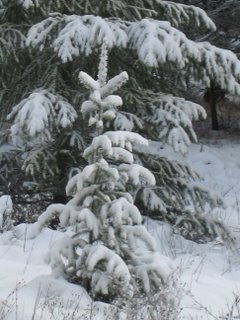But this creates a certain dilemma in a region where one's embrace of the term "defensible space" can be a matter of life or death, should you be unlucky enough to find yourself in the midst of a raging forest fire. In northwestern Montana, as in many other places here in the American west, how well you clear your property of "fuel" can sometimes determine whether your home is a complete loss or is only lightly charred.
I find it difficult not to cheer the little upstarts that take root in my corral and even in the patch of land in front where the lupines grow in spring. I feel the same way about the ones that have poked up in the protective shadow of the house. They're small, they're uppity and they're ambitious -- all qualities I cannot help but admire. But the fire people tell me I should "remove" them.
I'd hate to do it. I like them. Who wouldn't?

Blast it all, it rubs my fur the wrong way to yank out a tree. I'm simply not one of those people who can rearrange vegetation willy-nilly as though moving around the living room furniture. A neighbor once observed to me that she intended to remove a hundred-year old cottonwood in favor of "more manageable trees." My mouth yawped open, unable to speak.
More manageable trees? That seemed an unspeakably capricious reason to remove a tree, especially one as venerable as that cottonwood. To me, there ought to be a very good reason to remove a tree.
Like, perhaps, defensible space.
Right now, this is a question I need not face at the Ranch. There will be no lightning to spark a blaze for several months, and with the canopy of snow overlaying the winter forest, nothing would light anyway. But the dry summer months loom, inevitable, with hard choices their traveling companions.



6 comments:
This sounds exactly like my home in Seabeck, WA. We've just allowed all the little upstarts to make thier way. I can't wait to see what they look like when we finally return - what started as a carpet of 3-inch seedlings were a thicket of 6-to-10-foot-saplings when we left!
I can't believe I've never made the connection when you've mentioned Seabeck. That area -- as well as the other side of the Hood Canal -- is one of my favorite parts of the world.
I completely agree TH. There's just no where else quite like it. :)
I just saw a report on a new study that found that some artificially thinned forests in the West were actually more vulnerable to fires, because the lack of undergrowth dries out the forest floor! It seems that in some forest types, the only way to fight (infrequent, high-intensity) fire is with (frequent, low-instensity) fire.
That doesn't mean you shouldn't clear out the space around your house, of course. I recently had to cut down a huge old poplar tree that was threatening my parents' house. Hard to feel good about that.
Dave, I've read the same thing as well. If I recall, that was part of the argument over the alleged "Healthy Forests Initiative", was it not?
Ouch re the poplar. I think the bottom line is that sometimes it has to be done, but I grieve the necessity.
There's all sorts of sketchy stuff wrapped into the HFI... yeesh.
It's amazing how capable the forest is of managing itself if allowed to do so... the cycles of destruction and creation are inherent to the system!
Post a Comment